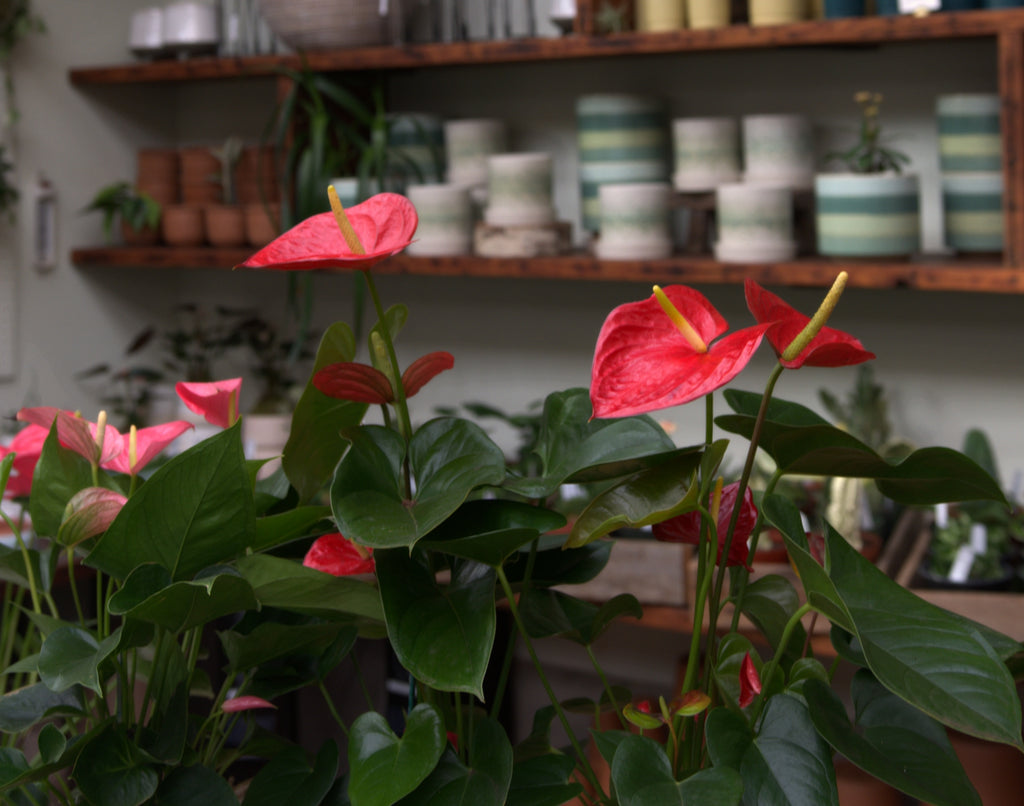Understanding your houseplant’s love language is key to fostering a thriving relationship with your plant. Just as humans express and receive love, so too do our planted companions. By recognizing and catering to a plant's individual "love language," we can develop a closer relationship to ensure long-term health and happiness.

Anthurium papillilaminum hybrids have some of the most velvety, heart-shaped leaves of any houseplants.
The Ways Our Plants Receive Love
Quality Time
The best way to develop a relationship with your plant is to spend time observing and watching the way your plant grows, reacts to light, and looks between waterings. Changes in leaf position, leaf texture, leaf shape, leaf color, stem shape, growth habit, and soil appearance can all point to your plant’s potential needs—for water, light, fertilizer, a repot, or a change in humidity.
In practice, observe your plant for a little each day. Watch new leaves unfurl. Notice that leaves angle toward the light. Observe your plant plump up after watering.

Pachypodium, Euphorbia, and cacti may be slow-growing, but subtle changes in their form appearance (especially shriveling between the spines) could indicate that it's time to water.
Physical Touch
Although it’s fun to pet and touch leaves, many plants don’t like too much handling. Leaves that are fuzzy or very thin can get damaged from our touch. However, some plants’ leaves change in texture when they are in need of water. A plant’s normally succulent or stiff leaves can feel lax, shriveled, or flimsy when the plant is ready for a drink.
Succulents like jade, Aloe, and Haworthia feel loose and squishy when they are ready for more water. The leaves of tropical succulents like Hoya and Peperomia feel flimsy and look wrinkled after prolonged drought. Even the leaves of staghorn ferns and pothos vines will feel thin and pliable when left dry for too long.

Air plants like this Tillandsia ionantha have leaves covered in fuzzy trichomes to help it better absorb water. To protect these fragile structures, avoid rubbing and touching the leaves too much.
Acts of Service
For most tropical houseplants, regular watering is essential to maintain a happy healthy plant. As a general rule for most plants, we water when the top half of the soil feels dry to the touch. Because environmental factors like temperature, light levels, and humidity are constantly changing, we like to let our plants tell us when it’s time for water. Dry soil, a lightweight pot, shriveled stems, thin leaves, and a deflated appearance are good indicators that it’s time for a thorough watering.
With consistent care, you and your plant can build a long-lasting bond based on trust and love.

Anthurium magnificum and most other tropical plants look their best with regular water. These plants naturally grow in rainforests and don't often experience periods of drought.
Gift Giving
The occasional gift can go a long way for your plant. For most tropical plants, a diluted well-balanced fertilizer can help a plant grow bigger, stronger, and faster. But just like in other relationships, be careful not to overdo it with the gift-giving. Too much fertilizer can burn the roots and leaves of your plant. Small, intentional gifts help keep your relationship with your plant going strong, and your plant may even reward you with beautiful blooms.

Cacti like Rebutia krainziana generally want an extra gentle, low-nitrogen fertilizer applied only during their growing season. Tropical plants like birds of paradise (Strelitzia) appreciate dilute fertilizer year-round, but it's less important during the winter months.
Words of Affirmation
Although it seems silly, speaking words of affirmation to your plant can help strengthen your relationship. Express gratitude for their beauty and the joy they bring to your home. Talking to your plant will help set your intentions to keep you mindful of any required maintenance—from watering to pruning to pest treatment.

With one of the more well-known aroid flowers, Anthurium andreanum hybrids bloom in many colors, but one of our favorites has big green leaves with the iconic red heart-shaped flower.
Multifaceted Love
Most plants want a combination of all five love languages to thrive in the home. By expressing love in a variety of ways, we begin to holistically understand our plant’s wants and needs and start to build a symbiotic relationship with the natural world. As an act of love, we invite you to sit with your plant and take the opportunity to understand what it needs from you. Should you, you’ll find it a harmonious, rewarding journey.
